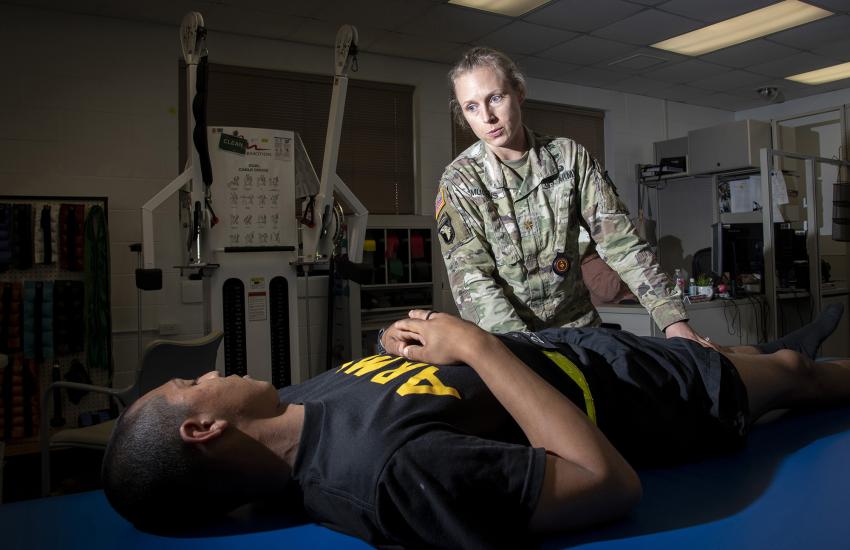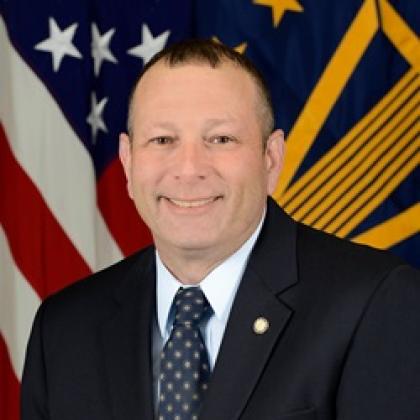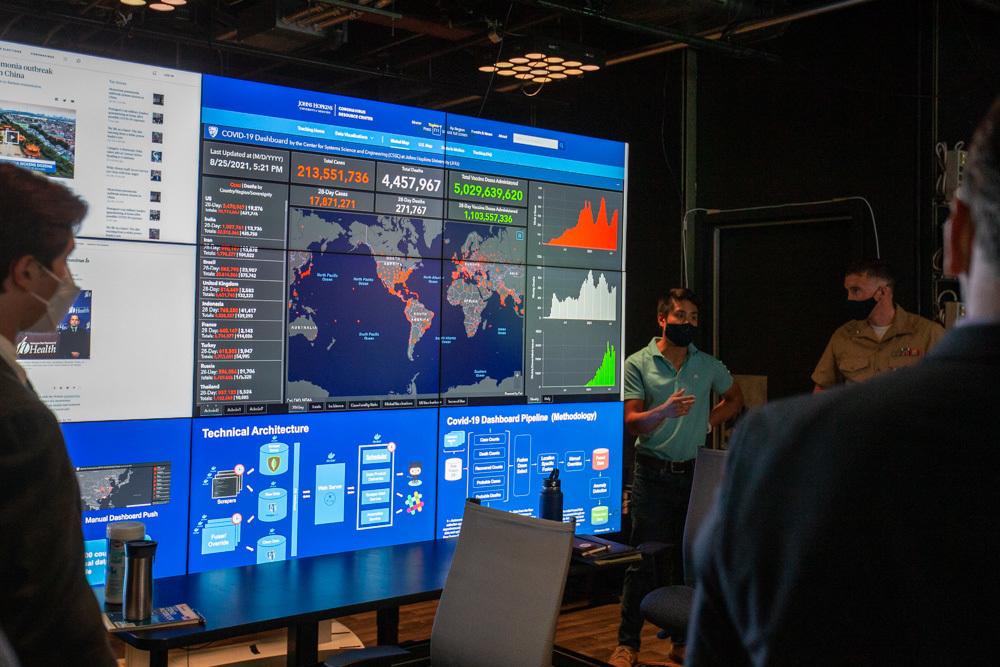Preparing Systems To Support Digital-First Health Care Delivery
Having tackled the set-up of some major medical information technology platforms, the Program Executive Office (PEO) for Medical Systems at the Defense Health Agency is examining emerging and other technologies to assist in providing digitally centered health care to warfighters around the world, said Chief Information Officer (CIO) and Program Executive Officer (PEO) for Medical Systems Thomas Patrick “Pat” Flanders, also known as the J-6.
Lt. Gen. Telita Crosland, USA, is the director of the Defense Health Agency (DHA), which is headquartered in Falls Church, Virginia. The DHA serves 9.6 million beneficiaries and operates nine medical centers, 36 hospitals, 525 clinics and 138 dental facilities worldwide. As part of Gen. Crosland’s 2023 Strategic Plan to build a modernized, integrated and resilient health care delivery system, the DHA is transforming “to an agile, data-driven, fully-integrated, virtual-first, human-centered model of care designed to meet the wartime skills and clinical currency of medical personnel; meet the medical readiness requirements of the armed forces at global scale; and deliver value- and outcome-based care to all our beneficiaries,” according to the plan.
The PEO is responsible for the continued development of affordable, innovative, robust and secure health information technology to the agency, the 11 U.S. combatant commands, and service members and has been a key component of the agency’s digital change. “When I started this job in November of 2017, DHA existed in name, but we had not yet taken over management and administration of all of the military treatment facilities around the world,” Flanders noted.
The first major step, the CIO said, was to consolidate different networks under the so-called Desktop to Datacenter program that united the separate Army, Navy and DHA Medical networks into one and added a single help desk called the Global Service Center. That effort also put in place specifications for compute and storage at the military’s hospitals, one cybersecurity service provider and one cloud access point.
“That standardization and being able to run the same [capabilities] really helped standardize how the information technology was being used across all of the treatment facilities in the world,” Flanders said. “Now, everybody is in one place, with standardized cybersecurity and the help desk. There is one phone number. Before, it was ‘Press one for Army, press two for Navy.’”
At the same time, the young agency created the electronic health record system, MHS GENESIS, Flanders explained. “That was equally huge because it replaced a hodgepodge of the ’90s-styled distributed architecture systems,” he noted. “For example, our inpatient system had 53 instances around the world in the basements of hospitals. There were 140 of our outpatient systems. Each hospital operated a different way. And when it came time for active-duty folks to retire and get their records, you were pulling from all the places that you had been stationed around the world throughout your career. So those two things really, really made a huge difference.”
Flanders cautioned that there are still “pockets” of siloed components of the electronic health record system. “It didn’t replace all of them,” he said. “There are still scheduling systems, phone tree systems, etc. Any place where we still have a separate Army, Navy and Air Force process for doing something, that is what we’re trying to chip away at. Although the heavy lift of all of that is definitely behind us.”
Meanwhile, the agency is also making strides in leveraging data as part of its new cloud-based Military Health System Information Platform that is harnessing AWS GovCloud capabilities, Flanders shared.
“When I took this job, we had multiple business information and analytics systems—create, replace, update, delete or CRUD [create, read, update and delete]-type—database systems that people were using for various reporting functions. And it was sitting on data unique to a location, and there were hundreds of them,” he stated. “Well, we combined them all into one giant data platform called the MHS Information Platform. All the data is now there in the cloud. And that’s been really helpful.”
Now that the data is accessible, the PEO is working to streamline the information to make it even easier to share across the agency, with the U.S. Department of Veterans Affairs and other organizations.
The PEO’s main push now, however, is supporting Director Crosland’s so-called “Digital Front Door” effort.
Designed to be an opening to the agency’s growing virtual health ecosystem, the program allows patients to use their own devices as part of a mobile or at-home health suite that provides features such as self-service prescription refills and appointment scheduling, secure patient-provider communications and lab results, automatic, systematic gathering of patient-generated health data from applications and wearables, visual displays and dashboards to record symptoms and track trends, and 24/7 patient access to and control of health information, according to the agency.
“What my boss Gen. Crosland wants is for patients to be able to use personal phones and computers and tablets to do as much as possible from home,” Flanders explained. “That is scheduling, seeing your records, seeing your labs, seeing a clinician if you need, and being able to navigate not just the DoD’s [Department of Defense’s] direct-care system but also being able to get referrals out to the indirect, private care system outside of the military facilities that the government operates.”
The PEO began with replacement of video capability of the electronic health record system and is adding a capability that allows the agency to provide behavioral health capabilities via personal cellphones and devices. “That is in the works right now,” the J-6 stated. “Those are being configured.”
To build on that digital foundation, the agency is currently considering emerging technologies, such as automation, artificial intelligence, machine learning and more wearables, which can be leveraged in the military health care environment to aid patient well-being and care. The PEO selected a group of so-called accelerators—clinicians and technical experts—that are evaluating advanced technologies and the possible related business process changes that might be needed at treatment facilities to adopt some of the capabilities from the commercial sector.
“Most of them are in Boston as we speak,” Flanders said. “They are looking at other health care networks, like St. Jude’s and JPL/[Boston Dynamics], places like that. They are meeting with a lot of commercial health care systems to glean different ways that people are using technology and how that may or may not be beneficial to us.”

This research will help the DHA determine which advanced medical capabilities they are going to build, how they will build them versus what technologies they will purchase, how to procure the commercial solutions and which technologies should come first, the J-6 noted.
“For us to do a lot of what is being talked about or to do what we see in other places, we’re going to have to change first to be able to adopt some of that,” Flanders acknowledged. “That is what’s being kind of looked at right now. ... From frictionless use for beneficiaries, seamless integration into the electronic health record, complete interoperability, to wearable devices for glucose monitoring or sleep apnea, chatbots, artificial intelligence or machine learning, to a foundation to grow future initiatives, [examining] all of the things that are possible.”
Artificial intelligence could be applied to optimizing medical reporting, workflows, filling out forms, and data identification across large sets of information. “We don’t have any of that yet,” he said. “We’re evaluating what others are doing.”
And notably, in some ways, the DHA’s digital environment is ahead of the commercial sector. While private practices offer varying degrees of digital access to laboratory results and interactions with physicians, each provider offers a separate, stove-piped system, leaving patients to navigate different platforms. “I would go as far as to say that we are better in the DoD than the commercial system when it comes to that,” the CIO stated. “Because now when we move around, we do have one system. You can move all around the United States, all around Germany, Korea, and you are in one system. But if you are not in the military and you moved from California to New York, you’re on your own.”
The DHA is also already employing automation and robotics, Flanders continued. “We actually have quite a bit of that now,” he stated. “It is just in places where the patients don’t see it.” For example, at the Madigan Army Medical Center at Joint Base Lewis-McChord, Washington, much of the distribution of medical supplies is performed by robotic systems—with robots that look almost like pallets on wheels that distribute to different areas around the hospital. In addition, pharmaceutical distribution, especially at the larger pharmacies, is controlled by robots. And several of the larger hospitals have robotic-assisted surgery—such as with the da Vinci surgical robot and others.
And naturally, cybersecurity remains a constant priority for the J-6. “The bar for cybersecurity in a DoD environment is definitely higher than it is in a commercial environment, and it costs more, and it takes longer,” Flanders emphasized. “I have a really good group of folks [at the PEO] that do that. It is frustrating to vendors that want to sell to the DoD that don’t have experience doing that. But it is better than it was. In 2017, if you were a vendor that wanted to sell something to the Military Health System, you got to do cyber maybe on the Army network, and then if you wanted to sell it to a Navy hospital, you had to totally redo it for the Navy, totally redo it for the Air Force. Now, at least you do it once.”
Beyond maintaining the medical network, supporting the electronic health record system and providing capabilities for the DHA’s Digital Front Door, Flanders does offer a wish list of technologies.
“I really would like a voiceover internet protocol [VOIP] network,” he said. “And I would really like to own the phones. With phones, there is an Army way, a Navy way, an Air Force way because they own the patch of ground that the wires come through. And all that was put in place when phones were kind of like sewers. Now they’re computers. Owning the phones would make incorporation with all the other things easier. It would allow us to use PCs as soft clients and incorporate it with other aspects of the buildings.”

Now, everybody is in one place, with standardized cybersecurity and the help desk. There is one phone number. Before, it was ‘Press one for Army, press two for Navy.’






Comments